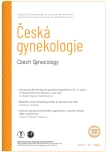Direct abdominal muscle diastasis and stress urinary incontinence in postpartum women
Authors:
R. Dudič 1
; V. Dudičová 1
; E. Vaská 2
Authors place of work:
Gynekologicko-pôrodnícka klinika, LF UPJŠ a UNLP, Košice Slovenská republika
1; Katedra fyzioterapie, Fakulta zdravotníckych vied, Univerzity Sv. Cyrila a Metoda v Trnave, Slovenská republika
2
Published in the journal:
Ceska Gynekol 2023; 88(4): 273-278
Category:
Původní práce
doi:
https://doi.org/10.48095/cccg2023273
Summary
Background: Currently, there are not enough studies comparing the width of the linea alba in women with and without stress urinary incontinence in postpartum women. The primary aim of the study was to compare the width (IRD) in postpartum women with and without symptoms of stress urinary incontinence (SUI). The secondary aim of the study was to compare pelvic floor muscle morphometry in postpartum women with and without SUI symptoms. Methods: IRD distance was measured with a linear probe via 2D US. Urinary leakage symptoms were assessed by the International Consultation on Incontinence Questionnaire (ICIQ – UI SF). Symptoms of overactive bladder were assessed by the Brief Urge Urinary Incontinence Symptoms Questionnaire (OAB-q). The functional status of the pelvic floor muscles was examined by manometry and pelvic floor muscle morphometry was examined by 3D/4D US. Conclusion: We compared IRD distance with and without SUI symptoms in postpartum women. The group of patients with stress urinary incontinence had a greater IRD distance at rest and during exercise compared to women without stress urinary incontinence. No worse pelvic floor muscle function and morphometry was found in women with SUI compared to women without SUI.
Keywords:
stress urinary incontinence – postpartum women – diastasis of the direct abdominal muscle
Zdroje
1. Thabet AA, Alshehri MA. Efficacy of deep core stability exercise program in postpartum women with diastasis recti abdominis: a randomised controlled trial. J Musculoskelet Neuronal Interact 2019; 19 (1): 62–68.
2. Bø K, Hilde G, Tennfjord MK et al. Pelvic floor muscle function, pelvic floor dysfunction and diastasis recti abdominis: prospective cohort study. Neurourol Urodyn 2017; 36 (3): 716–721. doi: 10.1002/nau.23005.
3. Bowman K. Diastasis recti: the whole body solution to abdominal weakness and separation. Washington: Propriometrics Press 2016.
4. Benjamin DR, Frawley HC, Shields N et al. Relationship between diastasis of the rectus abdominis muscle (DRAM) and musculoskeletal dysfunctions, pain and quality of life: a systematic review. Physiotherapy 2019; 105 (1): 24–34. doi: 10.1016/j.physio.2018.07.002.
5. Carlstedt A, Bringman S, Egberth M et al. Management of diastasis of the rectus abdominis muscles: recommendations for swedish national guidelines. Scand J Surg 2021; 110 (3): 452–459. doi: 10.1177/1457496920961000.
6. Hagovská M, Švihra J, Buková A et al. Effect of an exercise programme for reducing abdominal fat on overactive bladder symptoms in young overweight women. Int Urogynecol J 2020; 31 (5): 895–902. doi: 10.1007/s00192-019-041 57-8.
7. Hagovská M, Švihra J. Evaluation of duloxetine and innovative pelvic floor muscle training in women with stress urinary incontinence (DULOXING): study protocol clinical trial (SPIRIT Compliant). Medicine (Baltimore) 2020; 99 (6): e18834. doi: 10.1097/MD.0000000000018834.
8. Hagovská M, Švihra J, Breza J Jr et al. A randomized, intervention parallel multicentre study to evaluate duloxetine and innovative pelvic floor muscle training in women with uncomplicated stress urinary incontinence – the DULOXING study. Int Urogynecol J 2021; 32 (1): 193–201. doi: 10.1007/s00192-020-04516-w.
9. Hagovska M, Švihra J, Buková A et al. The impact of different intensities of exercise on body weight reduction and overactive bladder symptoms – randomised trial. Eur J Obstet Gynecol Reprod Biol 2019; 242 : 144–149. doi: 10.1016/j.ejogrb.2019.09.027.
10. Haylen BT, de Ridder D, Freeman RM et al. An International Urogynecological Association (IUGA) /International Continence Society (ICS) joint report on the terminology for female pelvic floor dysfunction. Int Urogynecol J 2010; 21 (1): 5–26. doi: 10.1007/s00192-009-0976-9.
11. Keramidas E, Rodopoulou S, Gavala MI. A proposed classification and treatment algorithm for rectus diastasis: a prospective study. Aesthetic Plast Surg 2022; 46 (5): 2323–2332. doi: 10.1007/s00266-021-02739-w.
12. Reinpold W, Köckerling F, Bittner R et al. Classification of rectus diastasis – a proposal by the German Hernia Society (DHG) and the International Endohernia Society (IEHS). Front Surg 2019; 6 : 1. doi: 10.3389/fsurg.2019.00 001.
13. Sperstad JB, Tennfjord MK, Hilde G et al. Diastasis recti abdominis during pregnancy and 12 months after childbirth: prevalence, risk factors and report of lumbopelvic pain. Br J Sports Med 2016; 50 (17): 1092–1096. doi: 10.1136/bjsports-2016-096065.
14. van de Water AT, Benjamin DR. Measurement methods to assess diastasis of the rectus abdominis muscle (DRAM): a systematic review of their measurement properties and meta-analytic reliability generalisation. Man Ther 2016; 21 : 41–53. doi: 10.1016/j.math.2015.09.013.
15. Dietz HP, Wong V, Shek KL. Simplified method for determining hiatal biometry. Aust N Z J Obstet Gynecol 2011; 51 (6): 540–543. doi: 10.1111/j.1479-828X.2011.01352.x.
16. Avery K, Donovan J, Peters TJ et al. ICIQ: a brief and robust measure for evaluating the symptoms and impact of urinary incontinence. Neurourol Urodyn 2004; 23 (4): 322–330. doi: 10.1002/nau.20041.
17. Coyne KS, Matza LS, Thompson CL. The responsiveness of the Overactive Bladder Questionnaire (OAB-q). Qual Life Res 2005; 14 (3): 849–855. doi: 10.1007/s11136-004 - 0706-1.
18. Coyne K, Revicki D, Hunt T et al. Psychometric validation of an overactive bladder symptom and health-related quality of life questionnaire: the OAB-q. Qual Life Res 2002; 11 (6): 563–574. doi: 10.1023/a: 1016370925601.
19. He K, Zhou X, Zhu Y et al. Muscle elasticity is different in individuals with diastasis recti abdominis than healthy volunteers. Insights Imaging 2021; 12 (1): 87. doi: 10.1186/s13244 - 021-01021-6.
Štítky
Dětská gynekologie Gynekologie a porodnictví Reprodukční medicínaČlánek vyšel v časopise
Česká gynekologie

2023 Číslo 4
Nejčtenější v tomto čísle
- Účinnost vakcinace proti lidskému papilomaviru v prevenci recidivy těžké cervikální léze
- Léčebné přístupy u recidiv karcinomu endometria
- Diastáza priameho brušného svalu a stresová inkontinencia moču u žien po pôrode
- Vplyv drenáže pupočníka po spontánnom pôrode na tretiu dobu pôrodnú
